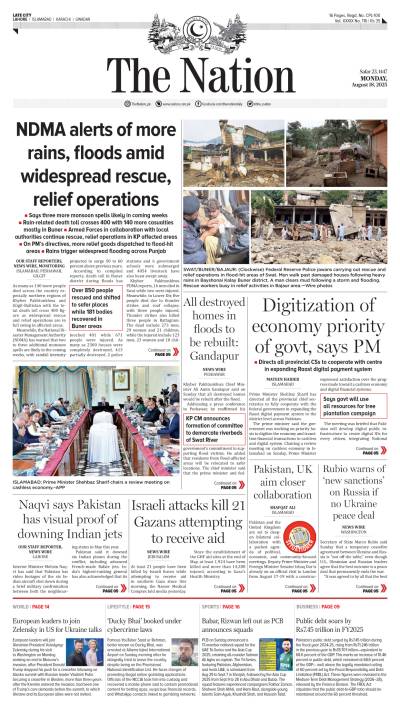On the eve of the Iranian President’s maiden visit to Pakistan, the government of Pakistan as a goodwill gesture has named 11th Avenue in Islamabad as the Iran Avenue. This is a unique step as it is the first time any road has been named after the name of a country and not the personality. In Tehran, there is a highway named after our Quaid-e-Azam Muhammad Ali Jinnah. This, therefore, marks the urge and sincerity on behalf of both governments to forge further good relations with each other.
The relations between Iran and Pakistan are deep-rooted. Iran was the first country to recognise Pakistan on its inception. Likewise, Pakistan was the first country to recognise Iranian Revolution. Pakistan’s national anthem is in the Persian language but one word. Allama Iqbal is revered as Iqbal Lahori in Iran for his Persian poetry which forms most of his work. The universities in Iran maintain the Iqbal Chair to accord prominence to the national poet of Pakistan. Both countries enjoy traditional and cultural affinity. Family norms, hospitality style, dresses, cuisines, etc are so much alike. If one visits Iran, most of the doctors employed in the hospitals are found to have been educated in Pakistan and speak Urdu quite fluently.
Pakistan and Iran share a common border of about 909km which dissects the land of Baluchistan on both sides. People living on either side are Baluch and share a common heritage. Cross-border trade and marriages are a common practice. So many Iranian products are brought inside Pakistan which are cherished by the Pakistanis. Likewise, Pakistani rice, mangoes, and oranges are hot favourite for the Iranians. Iranian POL products are also brought into Pakistan and people in border areas take benefit of this commodity.
Quite often, news on border issues between both countries has arisen which have been amicably resolved. Both claim there are terrorist outfits that reside in each other’s territory who have nefarious designs for the other. In the same trail, Iran in the month of January this year carried out aerial attacks on what it called strongholds of Jaish al Adl. Pakistan responded within 2 days by striking BLA targets inside Iranian territory. However soon after that, the escalation was controlled and the two sides started talking to each other thus resolving the matter amicably to the extent that President Raisi is visiting Pakistan now. This was a show of deft diplomacy from both sides which can be a textbook example on how to avoid a predicament between the two countries.
Despite having historical, cultural, and religious roots connected, both countries have not been able to gain much from each other. Iran has the second-largest gas reserves and fourth-largest oil reserves. It has half the population of Pakistan, in double the size of its territory. Among many other things, it grows saffron and olives which contribute significantly to its economy. The municipality system in Iran is a pinnacle of administration which is truly an emblem of discipline that the Iranian nation exhibits. The defense relations between both countries are also remarkable. Cross-over training, bilateral maritime exercises, naval diplomacy by both navies, and high-level defence visits exchange are all commonplace. There is growing understanding and regard between the two militaries who work in unison, especially at the border areas to defeat the menace of terrorism. Maritime tourism is another avenue that is awaiting the attention of both countries to be explored.
The visit of the Iranian President is a significant development on many accounts. It is the first-ever visit of President Raisi to Pakistan. He is also the first head of state to visit Pakistan after the new government of Pakistan was formed. The visit is amid the increasing hostilities between Iran and Israel and is therefore being closely watched by foreign observers. The visit is also important since Pakistan recently decided to revive the Iran-Pakistan gas pipeline even if it has to seek a US waiver. It is being speculated that the issues of border management and IP gas pipeline will top the agenda. Of course these are the two most burning issues, yet there are many avenues that both countries can take advantage of each other and learn from the best practices that they carry out.
Universally, the cheapest trade is with one’s neighbours. This principle of economics is simple and worth trying by both Iran and Pakistan. There are certain impediments in fully realising the true economic potential on both sides, yet ways and means exist that can be exploited to overcome this handicap. Both sides must therefore focus on their strategy to create economic stakes in each other which will produce several dividends. Not that the economies of both countries will be strengthened but the people-to-people contact will also be enhanced which will be beneficial in understanding of each other. Also, in the realm of geopolitics, countries having sound economies can play a better and more effective role. Given the current situation in the Middle East in which Palestinians are being brutally butchered by Israel, there is conclusive evidence for strengthening economies of Muslim countries to play a substantive role in world politics.
Reema Shaukat
The writer works as Communication Strategist at the Institute of Regional Studies, Islamabad and can be reached at reema.asim81
@gmail.com







